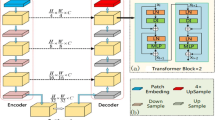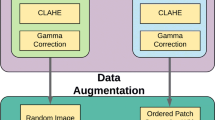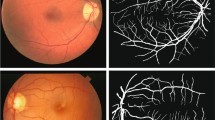Abstract
Retinal vascular status in fundus images is a reliable biomarker for diabetes, hypertension and many ophthalmic diseases. Therefore, accurate segmentation of retinal vessels is of great significance for the diagnosis of many diseases. However, due to the inherent complexity of the retina itself and the lack of data, it is difficult to obtain the ideal accuracy of the segmentation results of the vascular end. To solve this problem, we propose an innovative two stage cascades convolutional Neural network (TCCNNet) to segment the retinal vessels in fundus images. In stage 1, an entire down sampled fundus images is sent to a probability-anatomical-prior-guided shallow-layer-enhanced location net to perform rough segmentation. In addition, a novel circular inference module and parameter Dice loss are proposed to reduce the uncertain probabilities and false positive points of the boundary. In stage 2, high-resolution 2D image slices are reconstructed to offset the detailed information lost during downsampling, further refining the contours. Moreover, a multi-view 2.5D net composed of three 2D refinement subnetworks is applied to deeply explore the morphological features, compensating for the mistakes and missing spatial information of a single view. The proposed method is evaluated on different evaluation metrics such as sensitivity, specificity and accuracy. The experimental results show that this method shows the most competitive performance compared to other state of the art methods.





Similar content being viewed by others
References
Arokia Jesu Prabhu L, Jayachandran A (2018) Mixture model segmentation system for parasagittal meningioma brain tumor classification based on hybrid feature vector. J Med Syst 42(12):1–6
Badrinarayanan V, Kendall A, Cipolla R (2017) SegNet: a deep convolutional encoder-decoder architecture for image segmentation. IEEE Trans Pattern Anal Mach Intell 39:2481–2495
Chang X, Shen H, Nie F, Wang S, Yang Y, Zhou X (2016) Compound rank k-projections for bilinear analysis. IEEE Trans Neural Netw Learn Syst 27(7):1502–1513
Chen LC, Zhu Y, Papandreou G, Schroff F, Adam H (2018) Encoder- decoder with atrous separable convolution for semantic image segmentation. In: Proc. Eur. Conf. Comput. Vision, pp 833–851
Feng S, Zhuo Z, Pan D, Tian Q (2020) CcNet: a cross-connected convolutional network for segmenting retinal vessels using multi-scale features. Neurocomputing 392:268–276
Fu J, Liu J, Tian H, Li Y, Bao Y, Fang Z, Lu H (2019) Dual attention network for scene segmentation. In: Proc. IEEE Conf. Comput. Vis. Pattern Recognit, pp. 3141–3149
Ghiasi G, Lin T-Y, Le QV (2018) DropBlock: a regularization method for convolutional networks. https://arXiv.org/1810.12890
Hu J, Shen L, Albanie S, Sun G, Wu E (2020) Squeeze-and-Excitation Networks. IEEE Trans Pattern Anal Mach Intell 42:2011–2023
Jayachandran A, David S (2020) A new expert system based on hybrid colour and structure descriptor and machine learning algorithms for early glaucoma diagnosis. Multimedia Tools Appl 79(7):5213–5224
Jayachandran A, Dhanasekaran R (2013) Automatic detection of brain tumor in magnetic resonance images using multi-texton histogram and support vector machine. Int J Imaging Syst Technol 23(2):97–103
Jayachandran A, Dhanasekaran R (2017) Multi class brain tumor classification of MRI images using hybrid structure descriptor and fuzzy logic based RBF kernel SVM. Iran J Fuzzy Syst 14(3):41–54
Jayachandran A, Kharmega Sundararaj G (2016) Abnormality segmentation and classification of multi model brain tumor in MR images using Fuzzy based hybrid kernel SVM. Int J Fuzzy Syst 17(3):434–443
Jin Q, Meng Z, Pham TD, Chen Q, Wei L, Su R (2019) DUNet: a deformable network for retinal vessel segmentation. Knowl-Based Syst 178:149–162
Lam B, Gao Y, Liew AW (2010) General retinal vessel segmentation using regularization-based multiconcavity modeling. IEEE Trans Med Imaging 29:1369–1381
Li Z, Nie F, Chang X, Yang Y, Zhang C (2018a) Rank-constrained spectral clustering with flexible embedding. IEEE Trans Neural Netw Learn Syst 29(12):6073–6082
Li Z, Nie F, Chang X, Yang Y, Zhang C (2018b) Dynamic affinity graph construction for spectral clustering using multiple features. IEEE Trans Neural Netw Learn Syst 29(12):6323–6332
Li Z, Yao L, Chang X, Zhang K, Sun J, Zhang H (2019) Zero-shot event detection via event-adaptive concept relevance mining. Pattern Recogn 88:595–603
Li X, Jiang Y, Li M, Yin S (2021) Lightweight attention convolutional neural network for retinal vessel image segmentation. IEEE Trans Ind Inform 17:1958–1967
Luo M, Chang X, Nie L, Yang Y, Hauptmann AG, Zheng Q (2018) An adaptive semisupervised feature analysis for video semantic recognition. IEEE Trans Cybern 48(2):648–660
Mahiba C, Jayachandran A (2019) Severity analysis of diabetic retinopathy in retinal images using hybrid structure descriptor and modified CNNs. Measurements 135:762–767
Milletari F, Navab N, Ahmadi S (2016) V-Net: fully convolutional neural networks for volumetric medical image segmentation. In: Proc.- Int. Conf. 3D Vis., pp 565–571
Odstrcilik R, Kolar A, Budai J, Hornegger J, Jan J, Gazarek T, Kubena P, Cernosek OS, Angelopoulou E (2013) Retinal vessel segmentation by improved matched filtering: evaluation on a new high-resolution fundus image database. IET Image Process 7(4):373–383
Owen CG, Rudnicka AR, Mullen R, Barman SA, Monekosso D, Whincup PH, Ng J, Paterson C (2009) Measuring retinal vessel tortuosity in 10-year-old children: validation of the computer-assisted image analysis of the retina (CAIAR) program. Invest Ophthalmol vis Sci 50:2004–2010
Palanivel DA, Natarajan S, Gopalakrishnan S (2020) Retinal vessel segmentation using multifractal characterization. Appl Soft Comput 94:106439
Rezaee K, Haddadnia J, Tashk A (2017) Optimized clinical segmentation of retinal blood vessels by using combination of adaptive filtering, fuzzy entropy and skeletonization. Appl Soft Comput 52:937–951
Ronneberger O, Fischer P, Brox T (2015) U-Net: convolutional networks for biomedical image segmentation. In: Proc. Med. Image Comput. Comput. Assist. Intervention. pp 234–241
Samuel PM, Veeramalai T (2021) VSSC Net: vessel specific skip chain convolutional network for blood vessel segmentation. Comput Meth Programs Biomed 198:105769
Shelhamer E, Long J, Darrell T (2017) Fully convolutional networks for semantic segmentation. IEEE Trans Pattern Anal Mach Intell 39(4):640–651
Soares JVB, Leandro JJG, Cesar RM, Jelinek HF, Cree MJ (2006) Retinal vessel segmentation using the 2-D Gabor wavelet and supervised classification. IEEE Trans Med Imaging 25:1214–1222
Soomro TA, Afifi AJ, Gao J, Hellwich O, Zheng L, Paul M (2019) Strided fully convolutional neural network for boosting the sensitivity of retinal blood vessels segmentation. Expert Syst Appl 134:36–52
Sopharak A, Uyyanonvara B, Barman S (2013) Simple hybrid method for fine microaneurysm detection from non-dilated diabetic retinopathy retinal images. Comput Med Imaging Graph 37:394–402
Staal J, Abramoff MD, Niemeijer M, Viergever MA, Ginneken BV (2004) Ridge-based vessel segmentation in color images of the retina. IEEE Trans Med Imaging 23:501–509
Tang X, Zhong B, Peng J, Hao B, Li J (2020a) Multi-scale channel importance sorting and spatial attention mechanism for retinal vessels segmentation. Appl Soft Comput 93:106353
Tang X, Zhong B, Peng J, Hao B, Li J (2020b) Multi-scale channel importance sorting and spatial attention mechanism for retinal vessels segmentation. Appl Soft Comput 93:106353
Vaswani A, Shazeer N, Parmar N, Uszkoreit J, Jones L, Gomez AN, Kaiser L, Polosukhin I (2017) Attention is all you need. https://arXiv.org/1706.03762
Wang Q, Wu B, Zhu P, Li P, Zuo W, Hu Q (2020) ECA-Net: efficient channel attention for deep convolutional neural networks. In: Proc. IEEE Conf. Comput. Vis. Pattern Recognit., pp 11531–11539
Wu Y, Xia Y, Song YZ, Cai W (2020) NFN+: a novel network followed network for retinal vessel segmentation. Neural Netw 126:153–162
Xiang, Gao X, Zou B, Zhu C, Qiu C, Li X (2014) Segmentation of retinal blood vessels based on divergence and bot-hat transform. In: Proc. IEEE Int. Conf. Prog. Informatics Comput, pp 316–320
Yan Z, Yang X, Cheng K-T (2018) Joint segment-level and pixel wise losses for deep learning based retinal vessel segmentation. IEEE Trans Biomed Eng 65:1912–1923
Yan Z, Yang X, Cheng K-T (2019) A three-stage deep learning model for accurate retinal vessel segmentation. IEEE J Biomed Health Inform 23:1427–1436
Yan C, Chang X, Luo M, Zheng Q, Zhang X, Li Z (2021) Self-weighted robust LDA for multiclass classification with edge classes. ACM Trans Intell Syst Technol 12(1):1–19
Zhang J, Dashtbozorg B, Bekkers E, Pluim JPW, Duits R, ter Haar Romeny BM (2016) Robust retinal vessel segmentation via locally adaptive derivative frames in orientation scores. IEEE Trans Med Imaging 35:2631–2644
Zhang D, Yao L, Chen K, Wang S (2020) Making sense of spatio-temporal preserving representations for EEG-based human intention recognition. IEEE Trans Cybern 50(7):3033–3044
Zhou Z, Siddiquee MMR, Tajbakhsh N, Liang J (2020a) UNet++: redesigning skip connections to exploit multiscale features in image segmentation. IEEE Trans Med Imaging 39:1856–1867
Zhou R, Chang X, Shi L, Shen Y-D, Yang Y, Nie F (2020b) Person reidentification via multi-feature fusion with adaptive graph learning. IEEE Trans Neural Netw Learn Syst 31(5):1592–1601
Funding
This work was not supported from any Funding Agencies.
Author information
Authors and Affiliations
Corresponding author
Ethics declarations
Conflict of interest
The authors have no conflicts of interest to declare that are relevant to the content of this article.
Ethical approval statement
This article does not contain any studies with human participants or animals performed by any of the authors.
Additional information
Publisher's Note
Springer Nature remains neutral with regard to jurisdictional claims in published maps and institutional affiliations.
Rights and permissions
Springer Nature or its licensor holds exclusive rights to this article under a publishing agreement with the author(s) or other rightsholder(s); author self-archiving of the accepted manuscript version of this article is solely governed by the terms of such publishing agreement and applicable law.
About this article
Cite this article
Jayachandran, A., Shunmugarathinam, G. & Perumal, T.S.R. Retinal vessels segmentation of colour fundus images using two stages cascades convolutional neural networks. J Ambient Intell Human Comput 14, 9305–9315 (2023). https://doi.org/10.1007/s12652-022-04429-0
Received:
Accepted:
Published:
Issue Date:
DOI: https://doi.org/10.1007/s12652-022-04429-0




